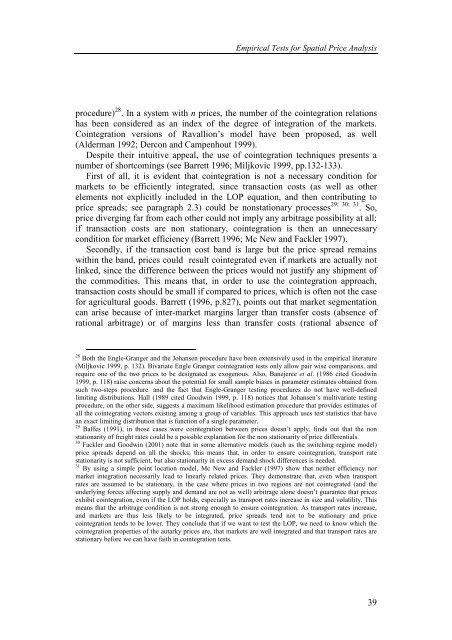TESTING INTERNATIONAL PRICE TRANSMISSION UNDER ...
TESTING INTERNATIONAL PRICE TRANSMISSION UNDER ...
TESTING INTERNATIONAL PRICE TRANSMISSION UNDER ...
Create successful ePaper yourself
Turn your PDF publications into a flip-book with our unique Google optimized e-Paper software.
Empirical Tests for Spatial Price Analysis<br />
procedure) 28 . In a system with n prices, the number of the cointegration relations<br />
has been considered as an index of the degree of integration of the markets.<br />
Cointegration versions of Ravallion’s model have been proposed, as well<br />
(Alderman 1992; Dercon and Campenhout 1999).<br />
Despite their intuitive appeal, the use of cointegration techniques presents a<br />
number of shortcomings (see Barrett 1996; Miljkovic 1999, pp.132-133).<br />
First of all, it is evident that cointegration is not a necessary condition for<br />
markets to be efficiently integrated, since transaction costs (as well as other<br />
elements not explicitly included in the LOP equation, and then contributing to<br />
price spreads; see paragraph 2.3) could be nonstationary processes 29; 30; 31 . So,<br />
price diverging far from each other could not imply any arbitrage possibility at all:<br />
if transaction costs are non stationary, cointegration is then an unnecessary<br />
condition for market efficiency (Barrett 1996; Mc New and Fackler 1997).<br />
Secondly, if the transaction cost band is large but the price spread remains<br />
within the band, prices could result cointegrated even if markets are actually not<br />
linked, since the difference between the prices would not justify any shipment of<br />
the commodities. This means that, in order to use the cointegration approach,<br />
transaction costs should be small if compared to prices, which is often not the case<br />
for agricultural goods. Barrett (1996, p.827), points out that market segmentation<br />
can arise because of inter-market margins larger than transfer costs (absence of<br />
rational arbitrage) or of margins less than transfer costs (rational absence of<br />
28 Both the Engle-Granger and the Johansen procedure have been extensively used in the empirical literature<br />
(Miljkovic 1999, p. 132). Bivariate Engle Granger cointegration tests only allow pair wise comparisons, and<br />
require one of the two prices to be designated as exogenous. Also, Banejeree et al. (1986 cited Goodwin<br />
1999, p. 118) raise concerns about the potential for small sample biases in parameter estimates obtained from<br />
such two-steps procedure, and the fact that Engle-Granger testing procedures do not have well-defined<br />
limiting distributions. Hall (1989 cited Goodwin 1999, p. 118) notices that Johansen’s multivariate testing<br />
procedure, on the other side, suggests a maximum likelihood estimation procedure that provides estimates of<br />
all the cointegrating vectors existing among a group of variables. This approach uses test statistics that have<br />
an exact limiting distribution that is function of a single parameter.<br />
29 Baffes (1991), in those cases were cointegration between prices doesn’t apply, finds out that the non<br />
stationarity of freight rates could be a possible explanation for the non stationarity of price differentials.<br />
30 Fackler and Goodwin (2001) note that in some alternative models (such as the switching regime model)<br />
price spreads depend on all the shocks; this means that, in order to ensure cointegration, transport rate<br />
stationarity is not sufficient, but also stationarity in excess demand shock differences is needed.<br />
31 By using a simple point location model, Mc New and Fackler (1997) show that neither efficiency nor<br />
market integration necessarily lead to linearly related prices. They demonstrate that, even when transport<br />
rates are assumed to be stationary, in the case where prices in two regions are not cointegrated (and the<br />
underlying forces affecting supply and demand are not as well) arbitrage alone doesn’t guarantee that prices<br />
exhibit cointegration, even if the LOP holds, especially as transport rates increase in size and volatility. This<br />
means that the arbitrage condition is not strong enough to ensure cointegration. As transport rates increase,<br />
and markets are thus less likely to be integrated, price spreads tend not to be stationary and price<br />
cointegration tends to be lower. They conclude that if we want to test the LOP, we need to know which the<br />
cointegration properties of the autarky prices are, that markets are well integrated and that transport rates are<br />
stationary before we can have faith in cointegration tests.<br />
39
















